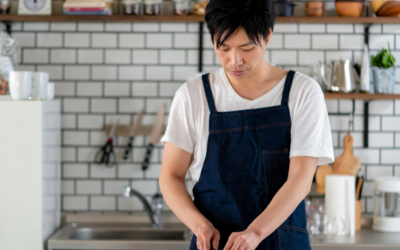How to Start a Collective Kitchen within your Community Organization?
However, starting a collective king might be intimidating. By asking yourself the right questions at the beginning of the project, you’ll be able to give a good start to your collective kitchen workshops.
1. What is the Origin of the Collective Kitchen Project?
Determining the origin of the collective kitchen project will make its development easier for you. Does the collective kitchen workshop come from a request of people frequenting your organization or is it an internal project for which you’ll have to bring together participants? Depending on the nature of your organization, your target audience varies – families, seniors, people in a disability situation, etc.
Collective kitchen is a way to save on the cost of meals, which are actually skyrocketing, but it is also a great tool to introduce popular education notions: working in groups, balancing a family budget, planning a recipe, knowing cooking basics. All of these are objectives pursued by a collective kitchen.
2. How to Put in Place a Collective Kitchen in a Community Organization, and What Are the Necessary Steps for the Process?
- ● The group: To put a collective kitchen in place, you first need to establish who are your participants – the human ingredient is the first of all! Make sure that your group is homogeneous, and that participants are pursuing the same objective. Your group may have a nice diversity, but collective cohesion is essential. For example, if the objective of your workshops is to reduce the grocery costs, a senior and a mother may both be interested by the same workshop. However, the portion calculation might be different based on the profile.
- The frequency: Collective kitchen workshops could become not-to-be-missed events for your participants. Before the workshop or during the first meeting, you can determine the frequency at which the workshops will take place: weekly, biweekly, monthly, etc. Make sure that the registered persons have the possibility to come on a regular basis to maintain the group cohesion.
- Starting ingredients: For the first collective kitchen session, you will need basic ingredients. You can either establish the pantry list with the people registered to the workshop as part of a preparation session, or prepare this basis before the initial workshop. [ajouter un lien vers une fiche de la boîte à outils] [ajouter un lien vers une fiche de la boîte à outils]
3. How to Involve the Participants in the Collective Kitchen Workshop Development?
The active involvement of the group is a key factor of the collective kitchen success. Depending on the autonomy level of the participants, you can include them in different levels of the collective kitchen workshop development. Selecting the recipes, setting up a budget, doing the shopping, these are all steps of the planning that will allow your group to acquire more autonomy in regard to knowledge related to food. All the recipe cards of the Toolbox can be downloaded as PDFs in which you can easily multiply portions.
When managing a collective kitchen, it is important that the communication be clear between all the members. This includes holding controls or regular meetings so that everyone can express their concerns or issues.
In addition, it is important to show flexibility and to be willing to adapt the rules of the group, as required. By following these advices, you can create a collective kitchen that works well, and effectively!
4. Why is it Necessary to Have a Space Suitable for Collective Kitchens?
The place where the activity is held is as much important as the group that has been formed.
First of all, you have to find a space appropriate for cooking. It must be large enough accommodate all the equipment and supplies you will need, as well as everything required to prepare meals. Don’t forget that collective kitchens have to follow MAPAQ’s (ministère de l’Agriculture, des Pêcheries et de l’Alimentation du Québec) standards. Le Regroupement des Cuisines Collectives du Québec (RCCQ) offers trainings on starting and facilitating collective kitchens. They can also support you in the implementation of your project.
When implementing the collective kitchen, you must ensure that the food preparation areas are in compliance with health standards, and that the cooling and heating units (refrigerator, freezer, oven, stove, etc.) work. Access to water is, of course, an essential prerequisite. Some organizations that are already fully equipped can lend equipment to other kitchens.
For a collective kitchen to remain successful over time, it is important to keep the space tidy and organized. It is also important to set up a food storage and rotation system.
A collective kitchen can provide multiple benefits to a community organization. It can contribute to strengthen the community cohesion by bringing people together for cooking and sharing a meal. It also gives an opportunity to teach new skills, such as cooking or nutrition, and it can provide a space where people have the possibility to share their culture and traditions. Collective kitchens can also represent a great way to reduce food consumption and save on the meal costs, while having access to healthy and nutritious foods.
Other tips you might be interested by!
8 Tips for Solo Cooking
8 Tips for Solo Cooking When living alone, cooking is not always super fun. Motivation is sometimes lacking, as well as inspiration. Moreover, it is a proven fact that the food distribution mode is often less favourable for people living alone than for families....
How to Cook with your Children
How to Cook with your Children Involving your children in the kitchen not only allows you to teach them practical skills such as cooking and food preparation, it also contributes to reduce food waste. Cooking with your children is an opportunity to share...
Substitution Table
Substitution Table Ingredients Amount Replace by: Chopped garlic 1 clove 1/8 tsp. of garlic powder. Buttermilk 1 cup 1 cup of milk plus 1 tbsp. of lemon juice or vinegar (let stand for 5 minutes). Butter 1 cup 1 cup of margarine. Unsweetened chocolate 1 square (1 oz)...
Contact us at
Phone
418 763-7707 ext.7
Address
50, 1st street West, Sainte-Anne-des-Monts
Quebec G4V 2G5
info@tcsagim.org
follow us on Facebook
facebook.com/TCSAGIM



